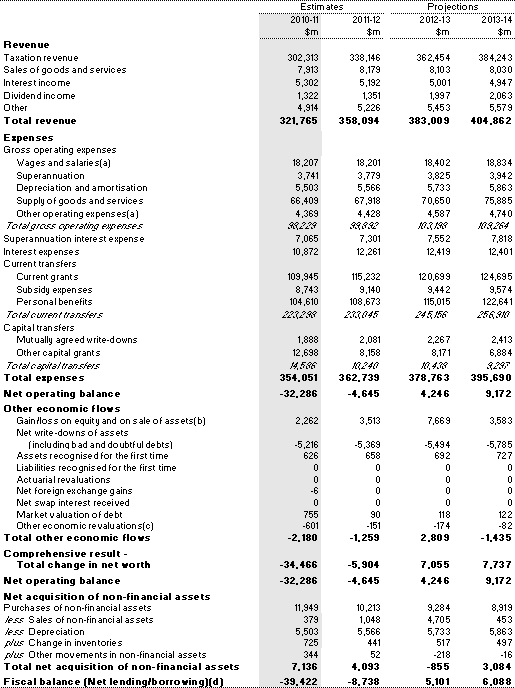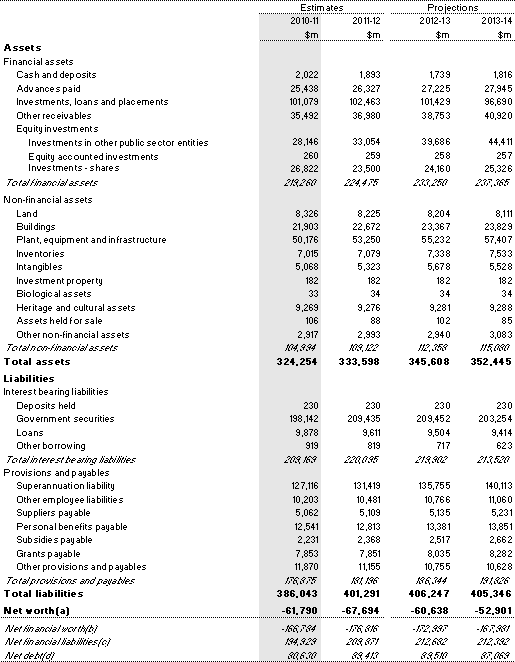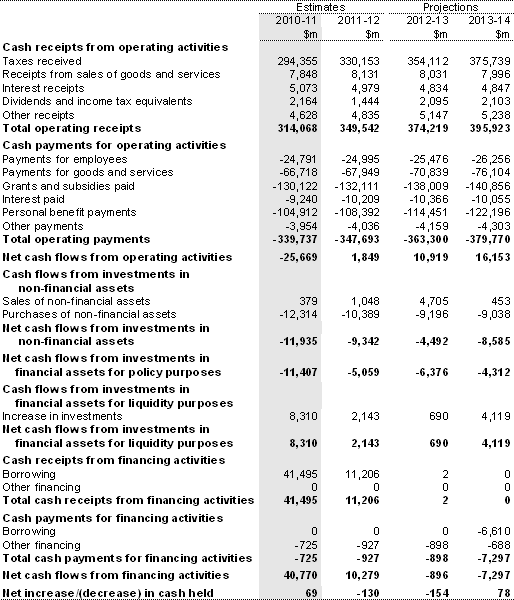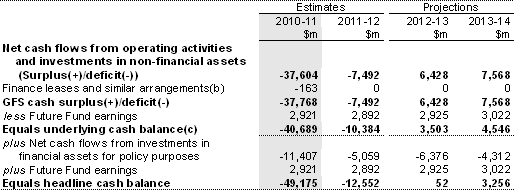The financial statements consist of an operating statement, including other economic flows, a balance sheet, and a cash flow statement for the Australian Government general government sector (GGS).
The Charter of Budget Honesty Act 1998 (the Charter) requires that the Pre-Election Economic and Fiscal Outlook be based on external reporting standards. These are:
- the Australian Bureau of Statistics’ (ABS) accrual Government Finance Statistics (GFS) publication, Australian System of Government Finance Statistics: Concepts, Sources and Methods, (cat. no. 5514.0), which in turn is based on the International Monetary Fund’s (IMF) accrual GFS framework; and
- Australian Accounting Standards (AAS), being AASB 1049 Whole of Government and General Government Sector Financial Reporting and other applicable Australian Equivalents to International Financial Reporting Standards.
The financial statements have been prepared on the same basis as the budget papers reflecting the Government’s accounting policy that ABS GFS remains the basis of budget accounting policy, except where the Government applies the AAS because it provides a better conceptual basis for presenting information of relevance to users of public sector financial reports. This is consistent with the presentation adopted by the Government in the 2010-11 Budget and the Economic Statement.
Budget reporting focuses on the GGS. The GGS provides public services that are mainly non-market in nature and for the collective consumption of the community, or involve the transfer or redistribution of income. These services are largely financed through taxes and other compulsory levies, user charging and external funding. This sector comprises all government departments, offices and some other bodies. In preparing financial statements for the GGS all material transactions and balances between entities within the GGS have been eliminated.
Further information on the reporting frameworks is provided in Statement 9 of Budget Paper No. 1, Budget Strategy and Outlook 2010-11.
Departures from external reporting standards
The Charter requires that departures from applicable external reporting standards be identified. The financial statements depart from the external reporting standards as follows.
Departures from ABS GFS
ABS GFS requires that provisions for bad and doubtful debts be excluded from the balance sheet. This treatment has not been adopted in the financial statements or in any reconciliation notes because excluding such provisions would overstate the value of Australian Government assets in the balance sheet. The financial statements currently adopt the AAS treatment for provisions for bad and doubtful debts.
ABS GFS treats coins on issue as a liability and no revenue is recognised. The ABS GFS treatment of circulating coins as a liability has not been adopted in the financial statements or in any reconciliation notes. Instead, the financial statements adopt the AAS treatment for circulating coins. Under this treatment seigniorage revenue is recognised upon the issue of coins and no liability is recorded.
Under ABS GFS, prepayments are classified as financial assets. In accordance with AAS, prepayments have been classified as non-financial assets in the financial statements. This is a classification difference that impacts on net financial worth.
ABS GFS currently requires Special Drawing Rights (SDRs) liabilities to be recorded as a contingent liability. The treatment of SDRs as a contingent liability has not been adopted in the financial statements or any reconciliation notes. The financial statements currently record SDRs as a liability. This is consistent with AAS, and also represents an early adoption of the ABS’ proposed revisions to GFS in line with revised international standards (refer ABS cat. no. 5310.0.55.001 Information Paper: Introduction of revised international standards in ABS economic statistics in 2009 and ABS cat. no. 5310.0.55.002 Information Paper: Implementation of new international statistical standards). The ABS will be updating its ABS GFS Manual following the update of the IMF GFS Manual 2001.
ABS GFS records defence weapons platforms (DWP) as a non-financial asset on a market value basis (fair value), rather than expensing at time of acquisition. The value used by ABS GFS is consistent with the National Accounts statistical methodology, and represents an early adoption of changes to the System of National Accounts 2008. The ABS GFS treatment of DWP is consistent with AAS, as non-financial assets can be valued at fair value as long as they can be reliably measured, otherwise cost is permissible. DWP will be valued at cost in the financial statements, as they have in previous budgets, while the Australian Government ascertains if a relevant and reliable fair value can be sourced.
Under ABS GFS, concessional loans are recognised at their nominal value, that is, they are not discounted to fair (market) value as there is not considered to be a secondary market. This treatment has not been adopted for the financial statements. Consistent with AAS, loans issued at below market interest rates or with long repayment periods are recorded at fair value (by discounting them by market interest rates). The difference between the nominal value and the fair value of the loan is recorded as an expense. Over the life of the loan the interest earned is recognised at market rates.
Departures from AASB 1049
AAS requires the advances paid to the International Development Association and Asian Development Fund to be recognised at fair value. Under ABS GFS these advances are recorded at nominal value. The ABS GFS treatment is adopted in the financial statements.
AASB 1049 requires the disclosure of the operating result and its derivation on the face of the operating statement. However, as this aggregate is not used by the Australian Government (and is not required by the Uniform Presentation Framework, agreed to by the Australian, State and Territory governments), it has not been disclosed on the face of the operating statement.
AASB 1049 requires disaggregated information, by ABS GFS function, for expenses and total assets to be disclosed where they are reliably attributable. ABS GFS does not require total assets attributed to functions. In accordance with ABS GFS, disaggregated information for expenses and net acquisition of non-financial assets was disclosed in the 2010-11 Budget.
AASB 1049 requires AAS measurement of items to be disclosed on the face of the financial statements with reconciliation to the ABS GFS measurement of items, where different, in notes to the financial statements. Reconciliation notes have not been included as they would effectively create two measures of the same aggregate.
Table A1: Australian Government general government sector operating statement

(a) Consistent with ABS GFS classification, other employee related expenses are reported under other operating expenses. Total employee expenses equal wages and salaries plus other operating expenses.
(b) Reflects changes in the market valuation of investments and any revaluations at the point of disposal or sale.
(c) Largely reflects other revaluation of assets and liabilities.
(d) The term fiscal balance is not used by the ABS.
Table A2: Australian Government general government sector balance sheet

(a) Net worth is calculated as total assets minus total liabilities.
(b) Net financial worth equals total financial assets minus total liabilities. That is, it excludes non-financial assets.
(c) Net financial liabilities equals total liabilities less financial assets other than investments in other public sector entities.
(d) Net debt equals the sum of deposits held, government securities, loans and other borrowing, minus the sum of cash and deposits, advances paid, and investments, loans and placements.
Table A3: Australian Government general government sector cash flow statement(a)

Table A3: Australian Government general government sector cash flow statement(a) (continued)

(a) A positive number denotes a cash inflow; a negative sign denotes a cash outflow.
(b) The acquisition of assets under finance leases decreases the underlying cash balance. The disposal of assets previously held under finance leases increases the underlying cash balance.
(c) The term underlying cash balance is not used by the ABS.